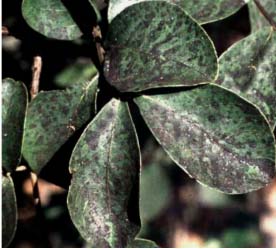What is Sooty Mould?
Sooty Mould is a collective term for different Ascomycete fungi, which includes many genera, commonly Cladosporium and Alternaria. It grows on plants and their fruit.
Causal Organism: Capnodium spp.
Symptoms –
- The disease is common in the orchards where mealy bug, scale insect and hopper are not controlled efficiently.
- The disease in the field is recognize by the presence of a black velvety coating, i.e., sooty mould on the leaf surface. In severe cases the trees turn completely black due to the presence of mould over the entire surface of twigs and leaves.
- The severity of infection depends on the honey dew secretion by the above said insects. Honey dew secretions from insects sticks to the leaf surface and provide necessary medium for fungal growth.

Mode of spread –
- The severity of infection depends on the honey dew secretions by the scale insects which provide the necessary medium for the fungal growth.
- Transmission occurs by air-borne ascospores.
Management:
| Cultural Practices | Chemical Control |
| Pruning of affected branches and their prompt destruction prevents the spread of the disease | Foliar spray of –Copper Oxychloride 50% WP @ 2 gm/litre. Neem oil @5 ml/litre (interval of 10 days) |
References: –
- https://agritech.tnau.ac.in/crop_protection/crop_prot_crop%20diseases_fruits_ber.html
- https://ppqs.gov.in/sites/default/files/ber.pdf
- https://crazygreenthumbs.com/2019/05/21/ants-aphids-honeydew-and-sooty-mold/








